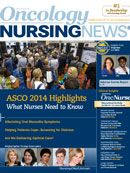Are We Delivering Optimal Care?
ASCO notes that by 2030, the number of new cancer cases in the United States will increase by 45%, and cancer will become the nation's leading cause of death, largely as a result of the aging of our population.
Lisa Schulmeister, RN, MN, APRN-BC, OCN®, FAAN
Editor-in-Chief OncLive Nursing
Oncology Nursing Consultant, Adjunct Assistant Professor of Nursing Louisiana State Health Sciences Center in New Orleans, Louisiana
In March 2014, the American Society of Clinical Oncology (ASCO) released its first-ever report on cancer care in the United States. ASCO notes that by 2030, the number of new cancer cases in the United States will increase by 45%, and cancer will become the nation’s leading cause of death, largely as a result of the aging of our population. At the same time, the number of people who have completed treatment (currently 13.7 million individuals) will continue to grow, and ongoing care and monitoring of these individuals will be required. Therefore, the population of people undergoing active cancer treatment and subsequent follow-up will continue to expand.
ASCO estimates that millions of people with cancer lack access to quality care, and rates of access to care are disproportionately lower for African Americans and Latinos. About 25% of uninsured people forgo care because of cost, and those without a regular source of care are less likely to obtain recommended cancer screening tests.
The Patient Protection and Affordable Care Act (ACA) is expected to provide more Americans with health insurance coverage in the coming years. However, the ACA alone may not resolve disparities in cancer care. The ACA expands Medicaid coverage, and some studies have shown that Medicaid is associated with less optimal outcomes for patients with cancer. In addition, millions of Americans will remain uninsured or underinsured even after the ACA is implemented.
Rising costs of cancer care are expected to continue, and this presents yet another barrier to access to care. Even insured patients may have high deductibles, large copayments, and significant out-of-pocket expenses. The indirect costs of cancer care also are now being calculated and include loss of income, transportation costs, and expenses associated with child care and home maintenance. The cost of cancer care is, and will continue to be, a burden for many patients.
ASCO estimates that by 2025, the demand for cancer care will grow by at least 42% while the supply of oncologists will grow by just 28%. In addition, fewer providers now work in rural areas compared with urban areas, which means that patients in less populated areas must travel to receive care. Small communitybased practices also are increasingly merging with other practices because of financial pressures and new expectations, such as the implementation of electronic medical records.
The adoption of health information technology is already transforming many aspects of cancer care, but additional advances are expected to occur. Within a few years, initiatives such as ASCO’s CancerLinQ and IBM’s Watson and Memorial Sloan Kettering Cancer Center will analyze data from large numbers of patients and be able to provide personalized treatment guidance. In addition, treatment is expected to be even more individualized to the patient as research in cancer genomics continues. Largely because of research in genomics and targeted therapies, the FDA approved 18 new cancer treatment drugs and biologics in 2013, bringing the total number of approved anticancer drugs to 170.
Escalating new drug costs are unsustainable for the healthcare system. Solutions need to encompass pricing, insurance coverage, and evidence-based practice to ensure that patients will not be burdened by high out-of-pocket costs. ASCO suggests proactive steps to reduce the use of unnecessary tests and ineffective treatments and recommends that patients receive the right treatment at the right time. For instance, mutation testing should routinely be conducted and patients should be engaged in end-of-life care discussions before such care is needed.
ASCO identifies two essential elements that will assist the oncology community in addressing the needs of tomorrow’s patients. First, the persistent barriers to high-quality care need to be reduced and hopefully eliminated. Secondly, greater efforts are needed to define and enhance the value of cancer care. Oncology nurses can play instrumental roles in these initiatives by advocating for patients’ access to care and by demonstrating the value of oncology nursing care.




